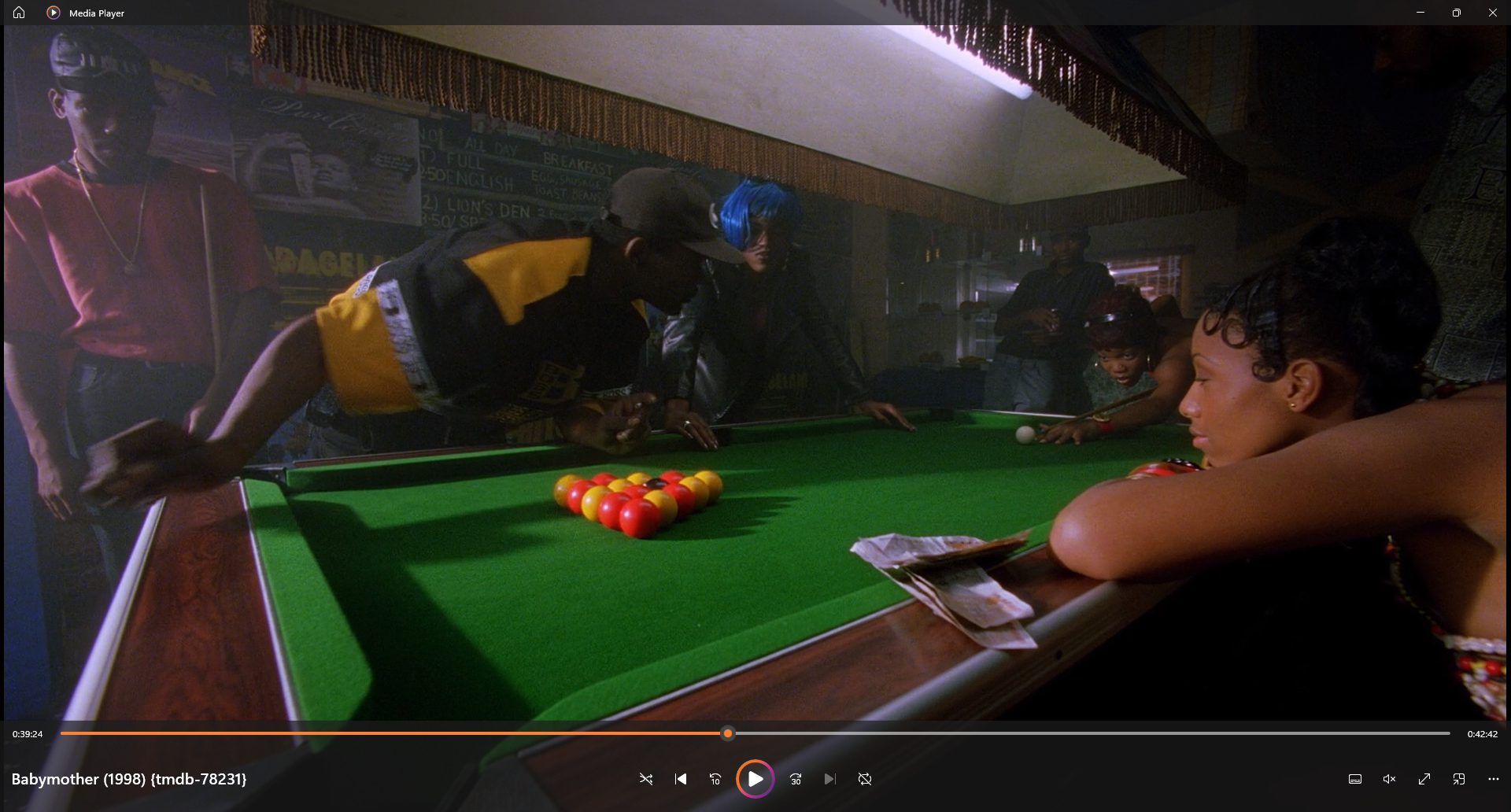JULY 2022, LOVE: Babymother (1998)
FLASHBACK: Year 1 of The Luminal Film Club. Our Year 1 theme was Love, and Julian Henriques’ 1998 film Babymother was our second ever pick. We all came away with the same sentiment: we really want to re-watch this film with Black British people.
ALERT: (THOUGHT PROVOKING) SPOILERS BELOW.
Our Babymother film club two years ago was a small group. We were all Black Americans - some of us with generationally American Black heritage, others of us with Caribbean heritage. The fantastic bit is this though: I recently got to follow through on our wish! I recently watched Babymother with a new Black British acquaintance! This watch was revealing and fulfilling.
A Lucid Watch
I first saw this film on Locally Grown TV. I had the pleasure of watching it on the first iteration of the platform. Quick digging told me that, for some, Babymother is considered Britain’s “first dancehall drama”. Even better, this title is the headline of the British Film Institute’s republication of Stuart Hall’s 1998 review of the film. I wondered then why the “first Dancehall drama” was worth taking note of. A good movie is a good movie is a good movie. And Babymother is enjoyable with it’s bite-sized components and three act structure. It also helps that one of my personal - though likely communally shared crushes, Suzette Llewellyn, plays a lovely, and lovingly, pivotal role. Oh those dimples.
Immersion
This third watch for me was just as lucid; but my lucidity comes from an unexpected place. What first struck me was how well lit each of the performers are. The film is often low-lit, set in dark, crowded places. But even then, even when the lighting isn’t luminescent, their skin shines straight through. And I smile.
And this lighting now - its not like this artistic thing, first and foremost. Its immersive, you know? Campy and immersive.
It’s not just the lighting that is campy and immersive. That’s the whole feel. Naturally, once I realize the camp, and the wacky styling, I immediately think - is the film supposed come off this queer? But then, what if campy and wacky come together into something other than queer? Particularly as a Black film, a Black British film? Am I seeing this in a white way? Is the truth of my sexuality, my gender, my vocation “coloring” things? Not to mention the class that comes along with this, and well, of course - I’m an outsider right?
So. What’s wacky, campy, and Black all over? (please let me know if that’s too much? As this is a free write… all the notes are). Or well, I wondered, what else could I be seeing that is very Black, but also wacky and campy? What if, perhaps, it is the way they take up space in the city. That there is a diasporic Black Caribbean space that is multigenerational, weighted under a ton of bricks of oppression, but still so, so nimble?
Girlish Grownness
Angela and Sharon and Yvette are girly, yet still grown. Two of the three of them are young Babymothers out of their depth, but they’re not immature. They have dreams, style, sex appeal and beefs. And when I say style - it’s really Zenon: Girl of the 21st century-like. Futuristic and alien but not dystopian. Bright, fluorescent. And, of course, it wouldn’t be a Caribbean women look without a lot of solid, bold metallic matte lip and eye looks. Like really, their outfits from the street to mothering to performing, feel campy and gay and outrageous and wacky. But also, completely legible - with the world (the diegesis) of the film, but also in my diasporic world - both the diasporic world of my dreams and my various realities. It’s more synthetic then “authentic,” and in a way that makes me lose even more interest in authenticity than I already have.
Rather than an authentic depiction of 90’s Dancehall culture / pan-Afro-Caribbean culture in London, what if we engage it as a code? A code seeding something…I’m not sure what though. I’m still an outsider.
I could make out components of a possible code thanks to watching it with a Black British person. They unspooled a thread of code centered on place. This place-centered code networks diasporic, community being, community being, Black woman being, Black motherhood being, being with racial conflict, and… and… and…
Being… Geospatial…
So they outlined a map of London for me, starting with the council estate where Angela lives. This estate was known as a center for Caribbean community life. This, unfortunately, also meant that it was, apparently, synonymous with violent crime - both racial conflict and well, perhaps even “urban crime”.
(I learned about the “Battle of Bamberbridge” which actually, has a lot to do with Black Americans).
COMMUNITY BEING
We also discussed how the community takes up space in the movie. Artist clashes where always kept in council centers and other community spaces, according to the family lore of my viewing partner. Battle of Bamberbridge, “violent crime” aside, brutalist architecture aside, the film is linked together by scenes of potent Black gatherings. Potent - not idealized, not healing, not even liberatory necessary - potent.
Even one of the outlier scenes - the funeral of Angela’s mother Edith - is one such scene. Gracefully, note the style doesn’t detour much from the template. Bold and well fitted (by funeral standards) - very clearly chief support and chief mourners.
It was this scene where I noticed Yvette, outside of her periwinkle blue bubble wrap overalls from the opening scene. Note also the plate in Yvette’s hand: the white bread with the cooked food. Her red polka dots and dark brown finger waves. How the bottom of Sharon’s chic silky bob meets the top of her black, fur-lined collar. Rose’s matching pearl set with her perfectly fitted Black suit and her experienced, though hidden, mask of concern. How their complexions melt into the background, and into one another, in a considered way. Just as the film is linked by scenes of potent community, the film is linked by its multiple, and unexpected, mother and children characters.
Babymother, be a Mother to Your Child
There are three generations of mothers in the film, and three generations of children. The trio mother one another, and Angela has both a big sister and a mother in Rose. Angela’s children have their mother, who mothers them as best she can, as well as their mother’s community - a care collective. And when they are on the outs with one another, they first must mother themselves and then mother and nourish each other. This is especially potent as Suzette Llewellyn’s Rose places an especially fierce mother character in the infamous 1996 film, Welcome II the Terrordome. And as it turns out in Babymother, Rose is herself a Babymother - a demure, proper, elegant, caring, ambitious, one who got away Babymother.
Mi Like Yuh
What’s also cool is that the men are corny as all get out. I mean, really truly. Nowhere near as bad as the trio, their maternal relations, their ambitions, their performances, their style. Nowhere. They’re jealous, they’re conniving, and when all else fails they turn to misogynoir. Like not even in a believable way. The male characters may truly be no deeper than plot devices, there to moving the storyline along.
They are marginal because they marginalize themselves through their misogynoir and their failure to show up for their families. They fail to nourish one another, themselves, their children, their partners. They don’t engage the broader community.
Other men are depicted in the community crowds. They blend, they dance, they whine, they chat, they drink. They contribute to the scene and commune in diaspora. Also, as usual, it is Black women who hold each other down and hold each other up. Across generations, through conflict and aggravation, being with their fussing and fighting. Peace is made, and the trio move on to the next play.
And so, I’ll end here, and with a bread crumb. There is a woman dancehall promoter in Babymother, Bee, who is trying to break into the also male dominated world of dancehall promotion. (She eventually sides with Byron, Anita’s Babyfather against her.) The actress, whom I believe is Diane Bailey, also makes an (archival) appearance in Morgan Quaintance’s short film, “Another Decade” (UK, 2018)! She appears in an old music video about a third of the way into the film, to contribute to Morgan’s overall point depiction of “the dynamic tension explored in the work is between, on the one hand, art-world actors speaking a truth to institutional power and, on the other, lived realities of London’s multiracial citizenry.”
I hope y’all enjoyed. Cheers!

![[film club] 2. we want to hear from you visuals.png](https://images.squarespace-cdn.com/content/v1/5c1b0e30ee1759b620bb59fb/1726762199223-0MZKF0Q0BV92HL1BF6Y4/%5Bfilm+club%5D+2.+we+want+to+hear+from+you+visuals.png)






































































